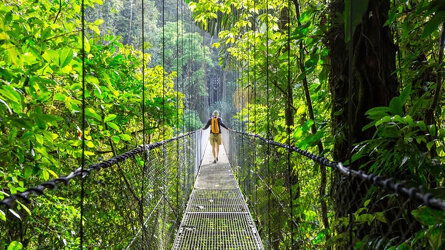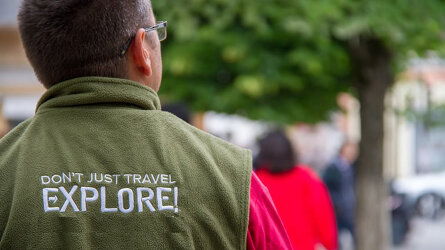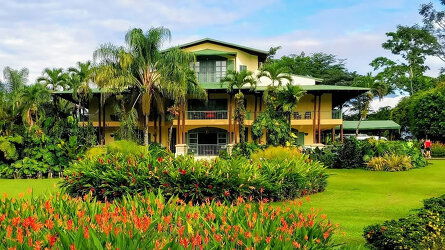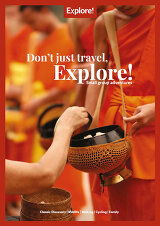Overview
Itinerary
Our tour starts today in Cusco, the old heart of the Inca Empire and the archaeological capital of the Americas. The Spanish-style city of today, with its pink tiled roofs, arcaded plazas and steep winding alleyways, stands upon Inca foundations. Its links with the Inca Empire are everywhere, from the stone walls that line the city streets, to the museums filled with artefacts and relics of a long-dead people.
For those arriving on time, our tour leader plans to meet you in the hotel reception at 6pm for a welcome meeting and for those that wish, there is the chance to go out for dinner. There are no activities planned today, so you're free to arrive in Cusco at any time.
If you'd like an airport transfer today, you'll need to arrive into Alejandro Velasco Astete International Airport (CUZ), which is around a 15-minute drive from our hotel. If you miss the welcome meeting, our tour leader will inform you of any essential information as soon as you catch up.
If you arrive earlier in the day, you might like to relax and acclimatise to the altitude at the hotel or take a gentle stroll to the Plaza de Armas. Stay: Hotel Inkarri (Comfortable)
This morning, we take an immersive walking tour through the captivating city of Cusco, kicking things off in the colossal archaeological site of Sacsayhuaman, a stone fortress still at the core of Cusco's traditions. Winding our way along an old Incan trail, we head down to the colonial neighbourhood of San Cristobal, where the plaza will surprise us with a sweeping view over the city's tops. Navigating the narrow streets of the old city, we reach the aqueduct of Sapantiana, a hidden engineering marvel only known by locals. This aqueduct directs us to arty San Blas, where coffee shops converge with traditional artisan's workshops, we explore the cobbled calles, venturing inside the studios to marvel at the local craftsmanship.
Entering the main Plaza de Armas of Cusco, the focal point of the city, we're welcomed by the baristas of Three Monkeys Coffee who serve us the finest Peruvian beans. Revived, we'll continue walking, gazing upon the Qoricancha complex, once the Inca's most sacred site dedicated to the Sun God. Our final destination is Mercado de Wanchaq, a truly local affair jammed with rows of colourful stalls and filled with the aromas of seasonal fruit. Slurping freshly pressed juice we witness the sellers hawking their wares before returning to the hotel. The walking tour covers approximately 4 kilometres/2.5 miles, expected to take around four to five hours.
The afternoon is at leisure to rest and acclimatise - you might like to visit one of Cusco's museums. Stay: Hotel Inkarri (Comfortable) (B)
Today, we'll drive into the Sacred Valley, the ancient heartland of the Incas. We'll visit the complex of Inca ruins at Moray - huge semi-circular agricultural terraces that were used as a botanical laboratory by the Incas, an ancient experiment that shows how in tune the civilisation was with agriculture and Mother Earth. After a visit to the terraces, we'll drive to nearby Maras - this small, colonial town has a stunning location encircled by the Andean mountains, and we'll have a lunch stop here.
Before we continue our drive to Ollantaytambo, we'll take a panoramic view of the Maras salt pans. This enormous collection of dramatic terraces is a shock of white in the valley. After continuing to Ollantaytambo, we'll arrive at the railway station and catch the train to Aguas Calientes, the gateway to one of the greatest of all archaeological sites. The train slowly meanders down the valley, following the tumultuous waters of the Urubamba River through a series of rock-cut tunnels before emerging at the small town of Aguas Calientes, serenely nestling amidst a lush landscape of cloud forests. This evening there is the chance to soak in the nearby natural hot baths. Stay: Hatun Samay Hotel (Comfortable) (B)
Early this morning, we take a public bus up to the mountain complex of Machu Picchu, the fabled 'lost city' of the Incas and probably the most spectacular feat of engineering in ancient America. The existence of this exquisite masterpiece of ancient civilisation remained unknown to the outside world until it was 'discovered' by an American archaeologist, Hiram Bingham in 1911. Temples, stairways, palaces and gabled stone dwellings are scattered everywhere, testifying to the energy and ingenuity of the builders. Built in the mid-15th century by Pachacuti, the city was thought to have been a major agricultural centre for the Incan Empire and its inaccessibility seems to have preserved it from the looters of the intervening years, resulting in the remarkably well-preserved ruins that we see today.
In the afternoon, we'll return to Cusco, first by train to Ollantaytambo and the rest of the way by bus. Stay: Hotel Inkarri (Comfortable) (B)
We've left this day free for you to enjoy some time in Cusco. It's a fantastic place to take in the atmosphere, and there are plenty of museums to discover or markets to wander. A hot chocolate at one of the coffee shops surrounding the Plaza de Armas is also a lovely way to watch the rhythm of city life.
Our tour leader will also provide the opportunity to spend the morning with a walking tour of 'modern Cusco', looking at the current lives of Cusco residents, and how they have managed to blend historical places with modern businesses. For those who would rather have a full day free, there's no obligation to join our tour leader on this walk - Cusco is made for relaxing, meandering and enjoying a slice of Latin America. Stay: Hotel Inkarri (Comfortable) (B)
Today we transfer to Cusco Airport and fly via Lima to Quito. Quito is Ecuador's mountain capital and the second-highest capital city in Latin America (2,850 metres). One of South America's most beautiful cities, Quito lies in a narrow valley at the foot of the Pichincha Volcano, surrounded by snow-capped mountains and extinct volcanoes. Due to the flight options (via Lima), much of the day will be spent travelling and you'll arrive into Quito in the late afternoon or evening. Your Peruvian tour leader remains in Cusco, while you will meet your Ecuadorian tour leader on arrival into Quito. Stay: Ikala Quito Hotel (Comfortable) (B)
Ecuador's capital is one of the best-preserved colonial cities of the Americas, and a UNESCO Heritage Site with a rich blend of colonial architecture, imposing churches and busy markets. A drive to the top of nearby Cerro Panecillo affords us one of the best views across the city and the surrounding mountains, presenting us with an unparalleled vista of the encircling Andes from the viewing platform offered by the statue of the Virgen de Quito. If the traffic in the city is particularly bad, we may head up Itchimbia Hill - an alternative viewpoint offering equally fantastic views over the city. We will make our way back down into the city and visit some of the main sites in the historical centre, including La Compania church with its elaborate gilded altars, walls and ceilings, as well as Quito's largest and oldest colonial church, the Church of San Francisco, built in 1553.
We'll have some time free this afternoon. You may like to visit one of the city's many museums, visit the imposing Basilica, or discover the Old Town at your own pace, perhaps stopping for an empanada. Ecuadorian food is tasty - we'll find plenty of spicy ceviches, plantain, yucca and soups or stews on the menu as we travel around. Stay: Ikala Quito Hotel (Comfortable) (B)
The Galapagos are an isolated chain of volcanic islands supporting a distinct and unique flora and fauna, including prehistoric creatures found nowhere else on earth. Of the extraordinary animals to be found in the Galapagos, many are reptiles, such as the giant tortoise, land iguana and three species of non-poisonous snakes. There are also several species of turtle, which come ashore to mate. Up to three-quarters of a million seabirds flock to the islands, including a third of the world's blue-footed boobies, frigate birds, pelicans, cormorants, albatross and petrels. Of all the animals in this unique landscape, perhaps the most out-of-place is the penguin. Only 35 centimetres tall, the Galapagos Penguin can be seen swimming among tropical mangroves. Offshore it is common to see dolphins, sea lions and fur seals playing in the water.
The Galapagos National Park charges a visitor fee, payable on arrival, which funds park maintenance and supervision in the Galapagos, as well as ecological study, conservation and infrastructure development in Ecuador's other national parks. Entry fees and the funds they generate for the national park system are among the measures taken by the Ecuadorian government to protect its natural heritage.
Today we fly to the island of Santa Cruz, the second-largest island in the Galapagos. It also boasts the most varied of the islands' vegetation zones. We visit 'Los Gemelos', two volcanic depressions that give us a deeper understanding of the formation of the islands, as well as passing through the evergreen highlands, where we will have the chance to see the iconic giant tortoises. In the afternoon we're at leisure to discover the island's main town, Puerto Ayora. Stay: Hotel Deja Vu (Comfortable) (B)
This morning, we leave Santa Cruz and journey west by speed boat for approximately two and a half hours. Our destination is nearby Isabela Island, where we'll spend the next two days.
The largest of the Galapagos Islands, Isabela is formed from five volcanoes, of which two are still active. An idyllic paradise of white sand beaches and swaying palms, it's home to the second-largest caldera on earth and the highest point in the archipelago. We'll base ourselves here, in the small town of Puerto Villamil on the southern coast.
On arrival we'll visit the Arnaldo Tupiza breeding centre, where we'll discover the history of the famous Galapagos tortoise, including the centre's ambitious aim to restore their numbers and release them back onto the islands. We'll take the 1.5 kilometres/0.9 mile walk back to Puerto Villamil, via the Tunel del Estero (one of the island's lava tunnels), and two of the island's beaches, where we may see marine iguanas lounging about, sally lightfoot crabs on the rocky shoreline, or herons and lava gulls. Stay: Hostel Gran Tintorera (Comfortable) (B)
The beauty of staying on land during a trip to the Galapagos is having the opportunity to explore its volcanic side. The geological formation of the Galapagos lends itself to hiking, and the scenery is just as impressive as the wildlife. Today we start by taking a walk up the Sierra Negra Volcano, an immense 12-kilometre/7.5-mile-wide mass that dominates the southern half of the island. The walk up to the top is three hours, presenting us with some spectacular panoramic views of the Pacific, and across to the neighbouring islands.
In the afternoon, we plan to snorkel at Concha y Perla and spot some of the many marine species that the Galapagos have to offer - sea lion, iguana, turtle, ray and a diverse array of reef species might be sighted, varying throughout the year depending on the tides, the weather and the season. Snorkelling equipment is available for rent locally. Stay: Hostel Gran Tintorera (Comfortable) (B/L)
Formed from the volcanic lava flow, the tiny islets of the Tintoreras Islets are fantastic for viewing wildlife and are accessible by a short boat trip from Puerto Villamil. On land, there is an array of birdlife and an abundance of the famous marine iguanas that are endemic and unique to the Galapagos. In the water, turtles, Galapagos penguins and sea lions may be spotted swimming around.
The wildlife's complete acceptance of our presence is a testament to the incredible diversity and unique quality of the Galapagos Islands. It makes it possible to view birds, reptiles and mammals from as close as a few feet.
In the afternoon, we come back together for a boat journey back to Santa Cruz Island, where we'll spend the next three nights. Stay: Hotel Deja Vu (Comfortable) (B)
Today, we'll discover one of the smaller islands of the Galapagos, and our plan is at the mercy of the yacht schedule departing from Santa Cruz. The island visited could be either Seymour, Bartolome, Santa Fe or Plazas Island - but no matter which island we will certainly have a display of wildlife. We may see sea lions playing in the water just off shore, land or marine iguanas strolling around, magnificent red-throated frigate birds, blue footed boobies, swallow-tail gulls or Galapagos penguins. After exploring on land, we will also do some snorkelling at one of the nearby sites. This boat trip may include people not travelling with Explore. Snorkelling equipment is included as part of the boat trip.
Depending on the boat schedules, we might change the order of activities during your days in the Galapagos, and any change in daily schedule will be fully briefed to you in country by our tour leader. It's also possible that we will visit islands outside of the four above depending on the yacht providers. Stay: Hotel Deja Vu (Comfortable) (B)
This morning, we take a walk to Tortuga Bay (a 5-kilometre/3-mile return walk) where we'll have the opportunity to swim at one of the most spectacular beaches of the entire chain, an important turtle nesting ground.
After lunch, we'll visit the nearby Charles Darwin Research Station which has been responsible for conservation projects within the islands since 1959 (the centenary of the publication of Origin of the Species). During our time here, we'll visit the centre to learn more about the area's unique collection of animal and plant life. Stay: Hotel Deja Vu (Comfortable) (B)
Leaving the Galapagos behind today, we fly to Quito on the mainland (there may be a touchdown in Guayaquil en route). On arrival, we'll transfer to our hotel in the Tumbaco suburb of the city and enjoy a last evening together as a group. Stay: San José de Puembo Hotel (Comfortable) (B)
The trip ends after breakfast at our hotel in Tumbaco, Quito.
There are no activities planned today, so you're free to depart from Quito at any time. If your flight is departing later in the day, luggage storage facilities are available at our hotel. If you'd like an airport transfer today, you need to depart from Quito's Mariscal Sucre International Airport (UIO), which is around a 20-minute drive from our hotel. (B)
Trip Inclusions
- A two-week trip that combines two icons of wildlife and culture in Latin America
- Discover the incredible wildlife of the Galapagos on a hotel-based exploration of several islands
- Take the train to Machu Picchu and immerse yourself in the history of the ancient Inca civilisation
- Moderate pace tours are ideal if you want a holiday which combines exciting activities and experiences with plenty of time to relax and unwind. Typically you'll be active and busy for part of the day but then also have time to rest and recharge your batteries.
- Accommodation, itinerary and inclusions subject to change.
- Price is for land, cruise and internal flights as specified. Flights not specified are not included

Launching in 1981, Explore offer trips from over 130 countries - from classic small group tours. Read more

Explore's leaders are more than just your typical guide. They're your local expert are are passionate about sharing their expertise with you. Read more

The places Explore stay are every bit as important as the sights they visit and the things you do. Read more
Brochure

Explore Small Group Adventures (2024-25)
Availability
A definite departure means minimum numbers have been reached for this departure to operate. Your Global Journeys Travel Advisor will check the availability of your departure date when you enquire. Additional savings may apply. We guarantee the lowest price in Australia. T&C’s apply.
Tour & cruises prices are per person. Prices shown have savings applied, are subject to availability and may be withdrawn at any time without notice. Pricing and trip details are correct at this point in time, however are subject to confirmation at the time of booking and are subject to change by Explore. For cruise itineraries, cabin images are sourced from Explore. These should be treated as indicative only. Cabin inclusions, upholsteries and room layout may differ to the image(s) shown depending on the ship selected and your sailing dates.









